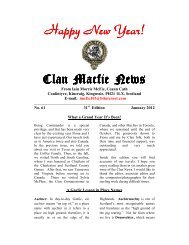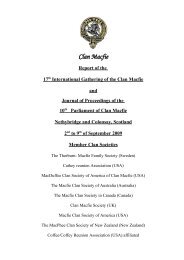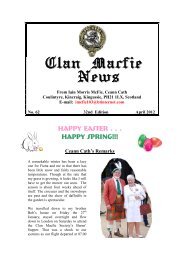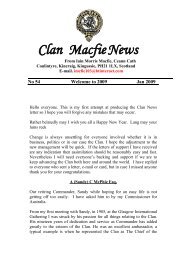Mythology, traditions and history - The Clan Macfie Society
Mythology, traditions and history - The Clan Macfie Society
Mythology, traditions and history - The Clan Macfie Society
You also want an ePaper? Increase the reach of your titles
YUMPU automatically turns print PDFs into web optimized ePapers that Google loves.
- 20 -<br />
<strong>The</strong> following list shows a much higher total, <strong>and</strong> they will be inadequate. Dr. Merrens<br />
estimates that about 5,000 Scots moved directly to North Carolina; other states contributed<br />
some portion <strong>and</strong> there might be as many as 10,000 Highl<strong>and</strong>ers in that state. 1<br />
Immigrants to North Carolina<br />
1743 - Hesseltine describes the Scotch-lrish as moving from Pennsylvania to Maryl<strong>and</strong> <strong>and</strong><br />
Virginia, from 1726 forward <strong>and</strong> from there to Granville, Bladen, Anson, Orange, Rowan <strong>and</strong><br />
Mecklenburg counties. 2<br />
1747-49 - 500 Scots came to the State <strong>and</strong> settled in what is now Cumberl<strong>and</strong> <strong>and</strong> Anson<br />
counties, under "Black Neil". Large numbers of MacDonalds <strong>and</strong> MacLeods came to this area,<br />
many from Skye.<br />
1750 - Hanna reports that "family after family <strong>and</strong> colony after colony swarmed in to<br />
western North Carolina from Virginia <strong>and</strong> Pennsylvania". <strong>The</strong>se were Scotch-lrish. <strong>The</strong>ir<br />
numbers were increased greatly by direct immigration in 1751, 1754 <strong>and</strong> 1755. 3<br />
1754 - <strong>The</strong>re were constant arrivals from Argyll <strong>and</strong> the Highl<strong>and</strong>s. Scots were established<br />
in Grenville, Orange, Rowan, <strong>and</strong> Mecklenburg counties. 4<br />
1767 - 50 settlers from Isle of Jura.<br />
1768 - Scotch-Irish migrated from Newry to Wilmington (Dickson).<br />
1769 - "Molly" from Islay arrived (Scots Magazine, 1769), the third emigration from Islay<br />
(Connor p. 55)<br />
Scotch-Irish from Newry, divided between North <strong>and</strong> South Carolina. (Dickson).<br />
100 Highl<strong>and</strong>ers arrived <strong>and</strong> two more vessels expected. (Scots Magazine, 1769).<br />
1770 - Scotch-lrish from Liverpool to Wilmington (Dickson).<br />
1771 - 500 persons from Islay to North Carolina.<br />
370 colonists from Skye. Tacksmen were included (Donaldson p. 62). This group is<br />
described by Graham as being the most wealthy <strong>and</strong> influential in Skye. <strong>The</strong>y applied for<br />
40,000 acres. (Graham).<br />
3 boatloads of colonists from Londonderry.<br />
1772 - 200 colonists from Sutherl<strong>and</strong> came on sailing ship. "Adventure". Later sailings<br />
brought this group up to 1,500. (Scots Bag. 1772).<br />
192 colonists from Sutherl<strong>and</strong> vis Greenock.<br />
Scotch-lrish colonists from Newry.<br />
1173 - 800 colonists from Skye (Graham, 50) largely MacDonalds.<br />
1 Merrens, H.R. Colonial North America in the 18th Century, Chapel Hill, 1964<br />
2 Hesseltine, W.B.; <strong>The</strong> South in American History, New York. 1943, pp.76-84<br />
3 Hanna, C. A.; Op. cit. Vol. II, pp. 34-38.<br />
4 Bolton <strong>and</strong> Marshall; Colonization of North America, New York. 1927 pp. 313-332.






